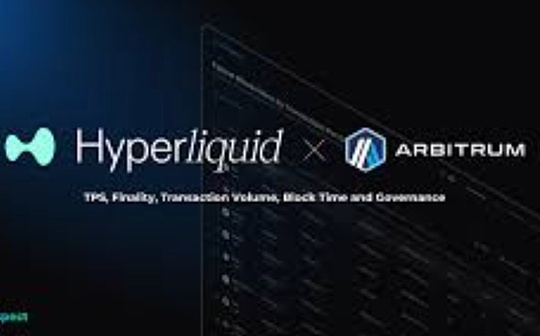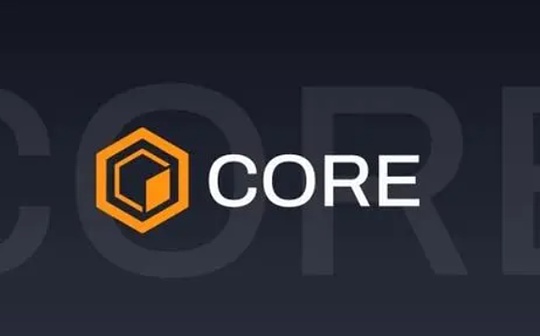
Press: A big narrative in this round of bull market is Bitcoin L2.Recently, the Core chain to the Bitcoin Core Chain Core has performed well, and the price has risen more than 6 times in half a month.MESSARI researcher Red Sheehan released a research report on April 4, 2024 to comprehensively analyze the Core chain. Bitchain Vision 0xjs translated this report to readers.
Point
Core Chain is the expansion and programmatic solution of Bitcoin.
Satoshi Plus is a mixed model of commissioned workload proof (DPOW) and entrusted equity proof (DPOS).This is the biggest difference between Core Chain and other Bitcoin layers.
Core Chain uses EVM as its execution environment.The developer community around EVM has helped develop a diversified ecosystem, including more than 10 native ecosystem projects and other projects introduced from other EVM ecosystems.
The control of Core DAO managed through the Core token is now mainly under the chain, but it is developing in the direction of a complete chain.
The CoreBTC Bridge is a multi -sign bridge specified in the agreement that does not need to be licensed.CoreBTC is cast by locking BTC on Bitcoin.This enables users to use BTC on the Core chain with fewer custody more than popular alliance bridges.
introduction
Bitcoin history has always focused on implementing point -to -point payment and becoming a value storage method, but does not pay much attention to DEFI, NFT, and other narratives for programming.Instead, these narratives are postponed to an alternative agreement, mainly Ethereum.However, Bitcoin is now experiencing a programmatic rejuvenation, which is largely due to the two recent two innovations: Ordinal theory and Bitvm.
After the ORDINALS yuan protocol and its BTC -based tokens are launched, it is undeniable that the Bitcoin community has a strong interest in NFT, homogeneous token and general programming.In December 2023, Bitcoin’s NFT sales (including technically non-homogenized BRC-20) surpassed the sum of Ethereum and Solana.This is especially important because they have been developing the NFT community for many years.
BITVM is a strategy that performs any calculation anywhere and then verified on Bitcoin to open the door for the idea of the new bridge mechanism and the effectiveness of mandatory transaction.Although some dimensions of L2 (such as data usability) are simpler, Bitcoin L2 still needs innovation to expand to support dozens of layers.Until the recent development, other functions, such as the effectiveness of not trusting bridges and compulsory transactions mentioned earlier, were considered by many people to be unable to achieve it without a soft fork.
Ordinal theory emphasizes the demand for additional functions, and then BITVM makes L2, which minimizes expression and trust.This triggered the enthusiasm of the Bitcoin layer, known as the “Bitcoin L2 Season”.However, some teams, such as Core Foundation, have been constructed in the Bitcoin ecosystem and are in the position of full use of the Bitcoin layer.Although many other floors are still constructing to the main network, the Core chain now provides a platform for Bitcoin programming.
background
Core chain is a Bitcoin layer (specifically the side chain) using EVM and novel Satoshi Plus consensus mechanism.Satoshi Plus is a combination of commissioned workload proof (DPOW) and entrusted equity proof (DPOS).Its design goal is to retain the decentralized security of Bitcoin, while achieving the scalability of a higher -performance smart contract platform.The parameters of Satoshi Plus and other aspects of the network are managed by the Core DAO (supported by the Core token) in a decentralized manner.Core Chain is compatible with EVM, similar to Binance Smart Chain’s realization of Geth.In the end, Core Chain has a built -in BTC bridge that makes BTC available on the network in the form of CoreBTC.
Core Foundation and Core DAO were established in May 2022.The Core Foundation is a self -raised fund. The component includes the contributor Rich RinesWorld Block Investor), Lindsey HaswellJoist founder/CEO and EHF investor researcher), MAX (with 18 years of entrepreneur, engineer and product designer experience) and Charles (master of computer science and theoretical degree, have previously held senior design of multiple web3 projects beforeDevelopers).
technology
Core Chain has four key features that make it stand out in the competition:
Satoshi Plus: The novel consensus mechanism is a mixture of DPOW and DPOS
Core DAO: DAO governed on the management chain
EVM: The modified version of the Ethereum virtual machine for the execution of the smart contract
CoreBTC: The core native bridge that is respected is connected to Bitcoin
Satoshi plus
The biggest difference between Core Chain and other Bitcoin layers (and general combined mining) is its Satoshi Plus consensus mechanism.Satoshi Plus is a mixed model of commissioned workload proof (DPOW) and entrusted equity proof (DPOS).
DPOW is performed by Bitcoin miners and mining pools, and they entrust the existing Bitcoin computing power to the verifications selected on the Core chain.DPOS is executed by the Core token holder to pledge/entrusts its Core token to the verifications selected on the Core chain.DPOW computing power and DPOS equity help to calculate the weighted scores, and determine which verifications are qualified to make the next round of block creation.Some parameters of the weight are variable and set by Core DAO; at present, the weight ratio of computing power is two -thirds, and the weight ratio of equity is one -third.
This hybrid model separates block production from Bitcoin miners, thus eliminating any possible motivation for Bitcoin miners to review the core chain.This novel method solves the classic problems of combined mining (and other forms of father -son sharing security).In this issue, the security provider network can perform MEV or review on the sub -chain without being punished, and there are no incentive measures without doing so, because they are theoretically more consistent with the parent chain.
Network participant role
Participants of the Satoshi Plus consensus include Bitcoin miners, Core pledgers, verificationrs, relatives, verifications and Core DAOs.They jointly protect the Core network through POW and DPOS and adjust the variables related to consensus through the governance process on the chain.
Bitcoin miner
Bitcoin miners and mining pools were excavated by mining Bitcoin blocks and subsequently entrusted these blocks to the core verifications of each block generated by them to participate in the Satoshi Plus consensus.This process involves adding data to the OP_RETURN field, which is used to contain any data used in many other network functions (such as inscriptions).The consensus process sends a signal to the Core network, indicating that the miners are entrusting their computing power to the verifications and participating in Satoshi Plus.Miners do not need to pay any additional costs, and the miners can even include their own Core address in order to receive the Core tokens distributed in the consensus process.
Because this process is free for miners, the Bitcoin miners who are involved cannot be guaranteed to be consistent with Core.Therefore, block production is managed by a unique role (verification), and the miner entrusts its computing power to the verification.
This sharing security is separated by each miner alone.It is also non -competitive, which means that a single miner will not exclude the computing power to the core authenticator to eliminate the combination mining or sharing security of their participation in another network (for example, POX with Stacks).This non -competitive exception may be that other shared security models also require the release of data to the OP_RETURN field, which is limited to 80 bytes in the size of this field.
Core pledker
Core token pledges are participated in Satoshi Plus by entrusting the Core token to the verificationrs on the Core chain.
Verification
Verifications participated in Satoshi Plus by running the hardware and pledged their CORE token.The computing power of the miners, the entrusted person entrusts the equity to the verification person, the verifier is combined with their own rights and interests to create their weight scores.As an open and no license system, the verifications can also run Bitcoin miners themselves and entrust their computing power to themselves (if they choose).
In addition, pledge of native flow of the STCORE tokens.Theoretically, this will increase consensus participation, because users do not have to choose between pledge and liquidity in DEFI or other protocols.
Relay and verification
The relay followed the Bitcoin block head to the COE network through the light client on the chain to participate in the Satoshi Plus.Like all other characters in Satoshi Plus, the relay set does not require permission.Anyone can participate by registering and locking the refundable Core token deposit.However, relatives must register and pass verification to get rewards.
Verivers participate in the Satoshi Plus by identifying and reporting malicious behaviors in the network.If a malicious actor is found, the pledge of malicious actors may be cut or confiscated directly.When allocating block rewards, verifications are compensated for their monitoring.As an authentication, it is unauthorized.
Consensus process
Weigh
The combination of hash computing (from Bitcoin miners) and pledged Core tokens (from the Core client) can get the total score.The weighted formula only uses one dynamic variable, that is, the M parameter.The value of this parameter is set by Core DAO and can be changed at any time.The computing power and equity of each verificationer are measured by the direct linear percentage of the total value of all verifications, while the M parameters oppose the weight of hash values and equity.In other words, the M parameter 0.3 means that the hash value represents 30%of the total weight and 70%of the total equity of equity.
S = RHP/THP*M+RSP/TSP*(1-M)
in:
RHP = The hash computing power entrusted to the verification
THP = True Power
RSP = The rights and interests of entrusting to the verification
TSP = General equity
M = Dynamic weight that can be adjusted over time.
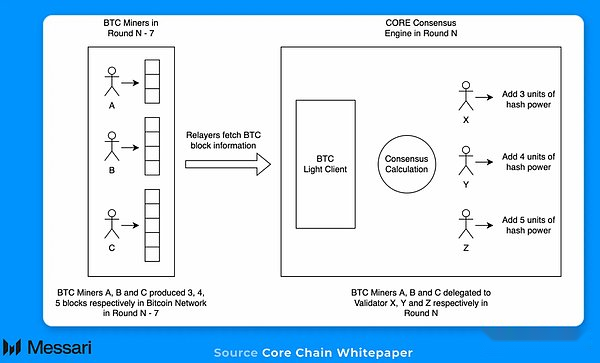
It is simple to measure equity because Satoshi Plus uses a linear voting mechanism (that is, a Core token is equal to one vote).The computing power is slightly complicated, because it is exogenous.The relay obtains BTC block information, brings Bitcoin’s consensus data into the Core Chain environment, and uses block production to estimate the hash value.The number of layers generated by the hash value is expressed by any miner, because in the long run, this ratio should be directly equal to the share of the miner’s total hash rate.
Each round (about one day), hash computing power is calculated by calculating the number of blocks generated by the miners a week ago (that is, today’s hash commissioning is determined by the block generation of the week).
Verification election and leader selection
The first 21 validator systems are ranked according to the weighted scores of computing power and equity.These verifiedrs can participate in block production.CORE uses its verifier election mechanism to create the first 21 verifications based on the mixed score, thereby creating a authentication set for the consensus period of 200 slots (called an EPOCH).Each slot has an opportunity to create a block for 3 seconds.Therefore, each EPOCH lasts for 600 seconds (ie 10 minutes) and provides verificationrs with the opportunity to create a maximum of 10 times (once it is accepted by an EPOCH).
Because Slot is distributed in a circular mode and is not randomly distributed, it is guaranteed that at least 9 slots (that is, opportunities) to create blocks for each verification.If the verifications are improper, it may be imprisoned and then delete from the legal number of the next Epoch.
award
Block rewards are composed of transaction expenses and coinbase rewards. They are allocated between verifications and system reward contracts. The system reward contract pays the fees from relatives and verifications.
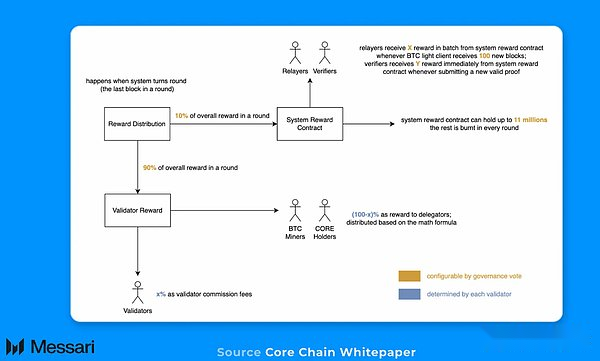
Vermitators receive consensus rewards in the form of transaction fees and Coinbase rewards, all of which are paid in Core.The verifications charge a certain fee (they set it as a personal commission), and then assign the rest to the miners and clients.Hash and equity clients allocate rewards based on the same M parameters. This parameter determines the weight between the hash and equity election of the verification person.
System reward contract cumulative rewards to pay the relay and verification person, these rewards must be received by all parties (instead of rewarding them to their representatives as representatives).The upper limit of the reward held in the contract is 10 million Cores and 1 million Cores of relatives and verifications.Any extra core rewards will be burned.
Ethereum virtual machine compatibility
Core Chain uses Ethereum virtual machine (EVM) as its execution environment.Although this environment was originally created for Ethereum, it has been adopted by many other networks, including BNB, Avalanche, Arbitrum, Optimism, and ZKSYNC.
EVM is the most powerful execution environment in the encryption field and has the most active developers.Solidity is a popular EVM language, the most popular language among cryptocurrency developers.Core Chain can access this universal ecosystem, including all developers and encryption infrastructure known by EVM developers such as Ethereum, Polygon, BNB, Avalanche.Tools include Remix, Hardhat, Solidity, Truffle, Ethers.js, etc.Infrastructure includes Metamask, token standards (such as ERC-721 or ERC-20), blockchain browser, smart contracts, and intermediate parts such as IPFS.
Electric Capital’s 2023 developer report emphasizes the dominant position of EVM and developers’ interest in the broader Bitcoin ecosystem.The most remarkable is:
87%of multi -chain developers work at least one EVM chain
Bitcoin and Ethereum account for 40%of all cryptocurrency developers (excluding other EVM environments)
40%of Bitcoin developers focus on the number and expansion of Bitcoin
CoreBTC
Core Chain contains a BTC bridge in the protocol, which locks the BTC on the Bitcoin so that CoreBTC is cast on Core Chain.
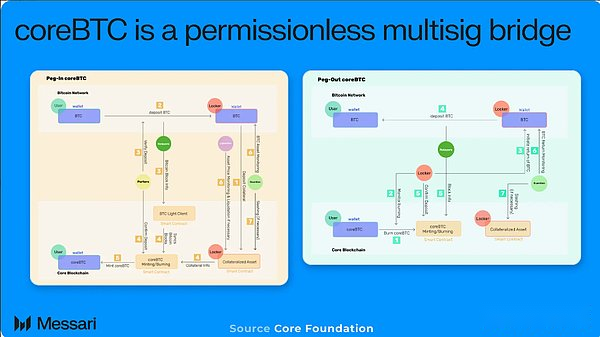
CoreBTC’s casting, protection and destruction operations are as follows:
Corebtc:
The user sends BTC to the bitcoin address of Locker
Porter monitor the Bitcoin blockchain and submit a transaction certificate to the Core chain smart contract
Intelligent contracts pass the bitcoin light client to verify the transaction and cast equivalent value of the equivalent value
Protect CoreBTC:
Locker stores excess mortgaged assets as mortgages
The liquidator monitor the mortgage ratio, if the mortgage fell too low, forced liquidation
The liquidator uses CoreBTC to purchase Locker’s tokens at a discount price to destroy CoreBTC
Is the guardian monitoring Locker’s improper behavior? For example, unauthorized transfer
Slash Locker mortgage as punishment, destroyed illegal equal value CoreBTC
Burning CoreBTC:
The user requests burning CoreBTC and specifies the Bitcoin address
Intelligent contract destroys CoreBTC and reminds Locker
Locker sends the equivalent BTC to the user’s address
The transaction is verified by Bitcoin light client
The main participants include:
user
Send BTC with mint corebtc
Ask to destroy CoreBTC to redeem BTC
Locker
Save the user’s BTC on the Bitcoin Blockchain
Storage in excess mortgage assets as mortgages
Send BTC to users to exchange CoreBTC
Porter
Monitor the Locker transaction on the Bitgian blockchain
Submit to Core Chain to prove to start CoreBTC casting
Core chain smart contract
Cast and destroy CoreBTC
Verify Bitcoin transaction through light client
Manage Locker mortgage and punishment
Bitcoin light client
Verify Bitcoin transaction of the core chain
Liquidator
Monitor the mortgage ratio of Lockers
If the mortgage fell too low, forced liquidation
Guardian
Whether there is an improper behavior to monitor the Locker
Triggered Locker mortgage punishment due to violations
Punishment
You can report to Locker illegal behavior to trigger punishment
The bonus part of the punished mortgage
Core token
CORE tokens are used for trading costs, pledge (and mining) rewards and governance.Its total supply is 2.1 billion, and it will be allocated through block rewards within 81 years.Core also has a slight deflation mechanism, because it can burn excess rewards for relatives and verificationrs.
Core Chain’s development is completely self -raised.The total supply of CORE was distributed between the contributors, users, miners, reserves, vaults and relay rewards.
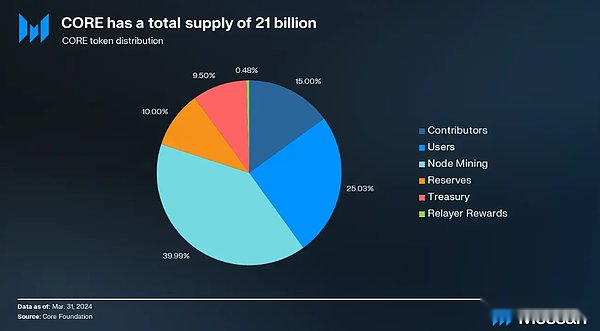
Govern
The Core DAO governance managed through the Core token is in the 1.5th stage, and the third stage is the ultimate goal of decentralization.The change of the Core chain is proposed by the core improvement proposal (CIP), and it can be proposed by any member of the community.
First stage: under -chain governance
The proposal was proposed under the chain and passed with a majority ticket.The voting period is 7 days.
The second stage: some chain governance
If you pass, the next stage of governance will allow voting to change the fixed parameters via the chain.M parameters have been treated, but this will extend it to other variables, such as percentage of combustion costs (currently 0%).There are also discussions on increasing time delay to prevent selling votes.
Third stage: comprehensive chain governance
At this stage, it is not fully enriched and is developed by the community.The idea includes a mortgage to release a proposal.
Core ecosystem status
Many protocols in the Core Chain ecosystem focus on BTC and BTC derivatives (that is, BTC -based Bitcoin native assets, such as Ordinals NFT).BTC is a large extent as an asset that has not been fully utilized, because the limited programming of Bitcoin script makes BTC activate BTC in the traditional DEFI protocol while maintaining asset custody to become challenging.Core Chain adopts a consensus mechanism combining the consensus of Bitcoin itself, aiming to provide a Defi environment that uses BTC assets with the minimum trust assumptions.Core Ignition is a six -month incentive plan that aims to promote more growth of Bitcoin DEFI.
The famous native projects that exist on the Core chain include:
GLYPH – DEX and Liquidity Center
Colend -Loan Agreement
Nlx -a perps dex
SpiritDex -Uniswap V4 style DEX
WizardNFT —— Core NFT and Bridge Bitcoin NFT Market
Corex -Social DEX
Pinksale -a launchpad
Element Wallet -a Core native mobile application with built -in chat and wallet features aims to be the end -to -end interface of Core Chain users.
Satoshi APP -a mobile application designed for the Core ecosystem airdrop, users can earn tokens that start the protocol starting on the Core Chain.
Bitstable -a stable coin issuer with BTC assets and Ethereum assets as mortgages
As discussed in the technical part, the Core chain has a built -in BTC bridge, but it also connects to the third -party bridge to interoperate with other ecosystems:
Layerzero — Connect Core Chain to Avalanche, BNB, Arbitrum, Polygon, and other networks
MULTIBIT-BRC-20 Bridge connecting Core Chain and Ethereum, BNB and Bitcoin
Core chain also has cross -chain DAPP and infrastructure derived from other ecosystems, including:
Pyth -prophecy machine service
Ankr -a RPC service
Icecreamswap and Sushiswap – DEX
The upcoming Core ecosystem project includes
NLX -Decentralization Exchange
The startup board and DEX for bridge order (NFT and BRC20)
Competitive pattern
Since the beginning of 2023, the Bitcoin layer has increased sharply.In the past, there were only 40 projects consisting of a small number of state channels, client verification (CSV) networks and side chains, although most projects are still developing.
Leading companies include Stacks, Rootstock, Liquid, and Lightning Network.Core Chain’s EVM compatible side chain model
Similar to Stack, they are all side chains.The consensus adaptation of the two networks (STACKS’s STACKING and Core Chain’s Satoshi Plus) not only depend on Bitcoin miners, but also rely on POS components to increase security.Stacks uses Clarity to execute the environment, which is not as powerful as EVM.
Similar to Rootstock, they are all side chains.The execution environment of the two networks is EVM.RootStock uses direct mining directly without any POS components, which is different from the Satoshi Plus consensus of Core Chain, the latter contains POS components.
Similar to liquid, they are all side chains.The function of liquid is more limited, unlike the complete EVM execution environment of the Core Chain Turing.LIquid is an alliance operation, not an open network for the Core chain.
Unlike the Lightning Network, the Lightning Network is a state channel.Unlike the Core Chain Turing complete EVM execution environment, the lightning network does not provide any additional functions (except for extension).Lightning network does not require any additional trust assumptions (that is, users can unilaterally exit the channel after the challenge period).Unlike Core CHAIN’s Satoshi Plus consensus, it trusts the Core node to fulfill the responsibilities of consensus and transaction integrity.
Recently, updated layers, such as Bob, Citrea, BISON, etc.Some of these participants are using EVM when exploring the development of Rollups.At present, due to technical restrictions, Rollup cannot exist on Bitcoin.However, this situation may change in a few years. Based on Bitvm and other innovations, it supports the key features that are considered to be regarded as rollup::
Enhanced the effectiveness of Rollup transactions on the Bitcoin L1 through effectiveness or fraud.Through fraud proves, Rollup will require a set of challengers without permission and openness, rather than a joint group like many BITVM -based model proposals today.
Store the necessary calling data on Bitcoin to re -create the Rollup state.
BTC is bridged with the minimum trust assumptions, allowing unilaterally withdraw from Rollup back to Bitcoin L1.
With the availability of technology, many existing side chains may reduce their trust assumptions and tend to the Rollup model.In addition, many of the upcoming Rollup will be initially launched as a side chain.Compared with the gradual development of Ethereum L2, this will be a similar route. Ethereum L2 has operated in the production environment for compulsory transaction effectiveness in almost any of the Ethereum L2 to enforce the effectiveness of the transaction.Essence
Roadmap
There is a series of development plans on the Core’s roadmap:
Non -custody BTC pledge: The third component of Satoshi Plus, any BTC holder can use an absolute time lock to entrusts it to the core verification person to exchange for the consonent.Host.
Native expense market: These can make transactions more predictive and cheaper.
Atomic exchange: Using HTLC, atomic exchange can be used for general purposes.
CoreBTC improvement: Integrate the consensus of CoreBTC and Core Chain’s Satoshi Plus and using multiple signature wallets to improve the security of assets.In addition, Locker can have more collateral choices.
CoreBTC as a GAS tokens: This will allow users to pay trading fees with Core or CoreBTC, and the user can interact with the ecosystem without any assets other than BTC.
Bitcoin LST: This will allow BTC pledges to earn benefits from their BTC, and also use the BTC for various applications on the core chain.
Correction: This will benefit other agreements from the Bitcoin protection of the Core chain.
Conclusion
In the past six months, the Bitcoin Layer has exploded, and people have a optimistic attitude towards Bitcoin’s programming.Core Foundation is one of the few teams that have been built in the Bitcoin ecosystem for many years. They found that they were in the position of full use of the Bitcoin layer.
Core Chain is the scalability and programming solution of Bitcoin. Its uniqueness is that its Satoshi Plus consensus, EVM execution environment, Core DAO governance and CoreBTC bridge.The Core chain community is constructing a Bitcoin -centric application ecosystem, and in the process, the security of Bitcoin is used as much as possible.In the next few months, the Core Chain plans to iterate its governance role and promotes the development of more ecosystems through incentive plans.
Original address: https://messari.io/report/understanding-core-chain

